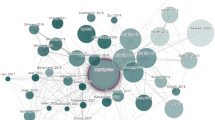Summary
Theoretical prediction of chromatographic retention could be used as a means of identification of organic compounds separated by gas chromatography. An optimum semi-empirical topological index,l ET(opt), is proposed for prediction of the chromatographic retention of the methyl-branched alkanes produced by insects. Our previously-developed semi-empirical topological index (l ET) has been improved to make it possible to distinguish between methylalkane isomers. The new topological index is based on the length of the chain, the positions of the methyl groups, and the number of methyl groups attached to the backbone. Simple linear regression between chromatographic retention and the proposed optimum semi-empirical topological indexes, for 178 methylalkanes with nine to forty carbon atoms in the linear chain, was very satisfactory (r 2=0.9999 andSD=3.20). The good predictive quality of the model is shown by the chromatographic retention indexes predicted for an external group of 30 methylalkanes.
Similar content being viewed by others
References
Koutek, B.; Hoskovec, M.; Streinz, L.; Vrkocova, P.; Ruzicka, K.J. Chem. Soc. Perkin Trans 1998,2, 1351–1356.
Katritzky, A.L.; Chen K.; Maran U.; Carlson, D.A.Anal. Chem. 2000,72, 101–109.
Carlson, D.A.; Bernier, U.R.; Sutton, B.D.J. Chem. Ecol. 1998,24, 1845–1865.
Heinzen, V.F.H.; Yunes, R.A.J. Chromatogr. 1993,598, 243–250.
Heinzen, V.F.H.; Yunes, R.A.J. Chromatogr. 1993,654, 83–89.
Arruda, A.C.; Heinzen, V.F.H.; Yunes, R.A.J. Chromatogr. 1993,630, 251–256.
Heinzen, V.F.H.; Yunes, R.A.J. Chromatogr. A 1996,719, 462–467.
Heinzen, V.F.H.; Cechinel Filho, V.; Yunes, R.A.IL Farmaco 1999,54, 125–129.
Soares, M.F.; Monache, F.D.; Heinzen, V.F.H.; Yunes, R.A.J. Braz. Chem. Soc. 1999,10, 189–196.
Soares, M.F.; Boeing, C.R.; Monache, F.D.; Heinzen, V.F.H.; Yunes, R.A.Anais Assoc. Bras. Quim. 2000,49, 24–30.
Amboni, R.D.M.C.; Junkes, B.S.; Yunes, R.A.; Heinzen, V.E.F.J. Agric. Food Chem. 2000, 48, 3517–3521.
Yunes, R.A.; Heinzen, V.F.H.; Cechinel Filho, V.; Lazzarotto M.;Arzneim. Forsch. Drug Res 2002,52, 125–132.
Junkes, B.S.; Amboni, R.D.M.C.; Heinzen, V.E.F.; Yunes, R.A.Chromatographia 2002,55, 75–81.
Heinzen, V.H.F.; Soares, M.F.; Yunes R.A.,J. Chromatogr. A 1999,849, 495–506.
Randic, M.; Pompe, M.SAR and QSAR Environ. Res. 1999,10, 451–471.
Randic, M.Int. J. Quant. Chem.: Biol. Symp. 1994,21, 215–225.
Calixto, F.S.; Raso, A.G.Chromatographia 1981,14, 596–598.
Calixto, F.S.; Raso, A.G.Chromatographia 1982,15, 521–524.
Calixto, F.S.; Raso, A.G.Chromatographia 1982,15, 771–775.
Bermejo, J.; Canga, J.S.J.; Gayol, O.M.; Guillén, M.D.J. Chromatogr. Sci. 1984,22, 252–255.
Macek, J.; Smolková-Keulemnsová, E.J. Chromatogr. 1985,333, 309–317.
Körtvélyesi, T.; Górgényi, M.; Seres, L.Chromatographia 1995,41, 282–286.
Király, Z.; Körtvélyesi, T.; Seres, L.; Górgényi, M.Chromatogrophia 1996,42, 653–659.
Author information
Authors and Affiliations
Rights and permissions
About this article
Cite this article
Junkes, B.S., Amboni, R.D.M.C., Heinzen, V.E.F. et al. Quantitative structure—Retention relationships (QSRR), using the optimum semi-empirical topological index, for methyl-branched alkanes produced by insects. Chromatographia 55, 707–713 (2002). https://doi.org/10.1007/BF02491786
Received:
Revised:
Accepted:
Issue Date:
DOI: https://doi.org/10.1007/BF02491786




